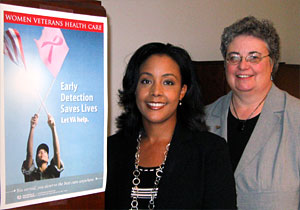
Breast Cancer Awareness Month Reminds Vets Not to Lose Focus on the Other 11 Months
Two very important words can save lives:
Early detection.
Dr. Stacy Garrett-Ray stresses that, “Mammograms can detect breast cancer early, and early detection makes a big difference in a woman’s chance of surviving.”
“Early detection makes a big difference in a woman’s chance of surviving.”
— Dr. Stacy Garrett-Ray, Deputy Director of Comprehensive Women’s Health, Women Veterans Health Strategic Health Care Group
Garrett-Ray is the Deputy Director of Comprehensive Women’s Health for VA’s Women Veterans Health Strategic Health Care Group and she is proud of VA’s record of caring for female Veterans.
“VA leads the nation in breast cancer screening for women…and we have for over 15 years. We have had the highest scores of making sure women get their mammograms.”
VA encourages all women between ages 50 and 75 to get mammograms every two years. Women ages 40 to 50 and those older than 75 should talk with their providers about the risks and benefits of having mammograms and make a decision based on their individual risk factors.
Both men and women can develop breast cancer, though male breast cancer is rare.
Dr. Patricia Hayes thinks Breast Cancer Awareness Month is important, but “Women Veterans should be aware of breast cancer all year. And not just cancer, but their overall health, their heart, other gender specific issues, everything.”
Hayes is VA’s Chief Consultant for Women Veterans Health.
“It’s important that they keep their own prevention scorecard and talk to their providers all year long.” The value of early detection is borne out in the statistics: The overall five-year survival rate from breast cancer is nearly 90 percent. If the cancer is caught while it is still located only in the breast, the survival rate increases to nearly 99 percent.
Women Veterans who develop breast cancer have their treatment completely coordinated through VA.
“We perform breast cancer surgery at seven of our medical centers,” Hayes notes. “And because cancer treatment is such a specialized service, for Vets in other areas we make sure the highest quality care is provided to them. And coordinate everything.”
A regular mammogram is one of the most effective ways to detect breast cancer early. VA excels at breast cancer screenings, outperforming private health care systems with 87 percent of eligible women receiving screening mammograms on time.
State-of-the-art digital mammography equipment is available at 32 VA Medical Centers, while each VA hospital has a designated women’s health care provider. Today VA is enhancing health care delivery to ensure that women Veterans will see the same doctor and case manager for years to come.
Breast cancer risk factors include getting older, having a close family member with breast cancer, being overweight or obese, previous radiation therapy/exposure to the breasts or chest, not exercising, and having certain gene mutations such as BRCA1 and BRCA2.
Having these risk factors does not mean that a woman or man will develop breast cancer, but may increase your chance of getting breast cancer in the future and should be discussed with your health care provider.
“I know a breast cancer diagnosis can be a frightening experience” Garrett-Ray says. “I tell patients that when we find the cancer early, there is approximately a 95 percent chance they will survive.
“I also want them to know that we have people to support them, that they are not by themselves.”
VA wants every woman to get appropriate screening. The VA directory, www.va.gov/directory, helps Veterans find their nearest facility.
Non-Veterans can find local screening resources through the U.S. Centers for Disease Control and Prevention’s early detection program at www.cdc.gov/cancer/nbccedp.
Big Changes Have Been Made
Hayes admits that she encounters situations where women Veterans who have not used VA are unsure what to expect, but should know that the care they would receive at VA medical centers will be top quality.
She states: “They will get excellent care through VA. If a Vet has not checked out the VA because of that misperception, I urge them to do so.”
“We did a telephone survey of 3,500 women who had received VA medical care and the results were overwhelmingly positive.”
Hayes came to her current VA job with more than 20 years of experience working every day with Veterans at the Pittsburgh VA.
As she described in a recent blog, “I had seen firsthand the areas in VA women’s health care that needed improvement, such as reproductive care, maternity care, emergency room services, and so on. And I worried that a woman might come to a VA facility, have a negative experience, and be instantly turned off and go away…that she would never receive the excellent health care she deserves.
“Well, big changes have been made in just the few short years since the launch of VA’s Women Veterans Health Initiative in 2008,” Dr. Hayes adds.
This progress includes:
- Improving access to care and enhancing services for women Veterans through new policies
- Publishing handbooks for Health Care Services for Women Veterans including maternity and reproductive care, as well as infertility evaluation and treatment
- Implementing comprehensive primary care for women Veterans
- Conducting cutting-edge research on the effects of military service on women’s lives
- Improving communication and outreach to women Veterans
- Providing mental health, homelessness prevention, and other services designed to meet the unique needs of women Veterans
- Training more than 1,100 providers in Women Veterans’ Primary Health Care to ensure women Veterans are offered a women’s health provider who is skilled in taking care of her health care needs
- Initiating training for VA emergency rooms to improve triage and diagnosis for conditions more common in women, including aspects of pregnancy and maternity care
- Including in VA pharmacies more of the contraception drugs that women need
- Adding women’s shoes, glasses, and wigs to medical equipment supplies
- Spending over $390 million on remodeling and construction to ensure that exam and inpatient rooms are private and provide dignity to all Veterans’ hospital experiences
- Placing a Women Veterans Program Manager (WVPM) in every VA Health Care facility to lead in the roll-out of enhanced services for women, act as an advocate and resource for women Veterans, and ensure delivery of the care they deserve.
Learn more about Women Veterans Health Care at www.womenshealth.va.gov and at My HealtheVet.
ATTENTION READERS
We See The World From All Sides and Want YOU To Be Fully InformedIn fact, intentional disinformation is a disgraceful scourge in media today. So to assuage any possible errant incorrect information posted herein, we strongly encourage you to seek corroboration from other non-VT sources before forming an educated opinion.
About VT - Policies & Disclosures - Comment Policy




